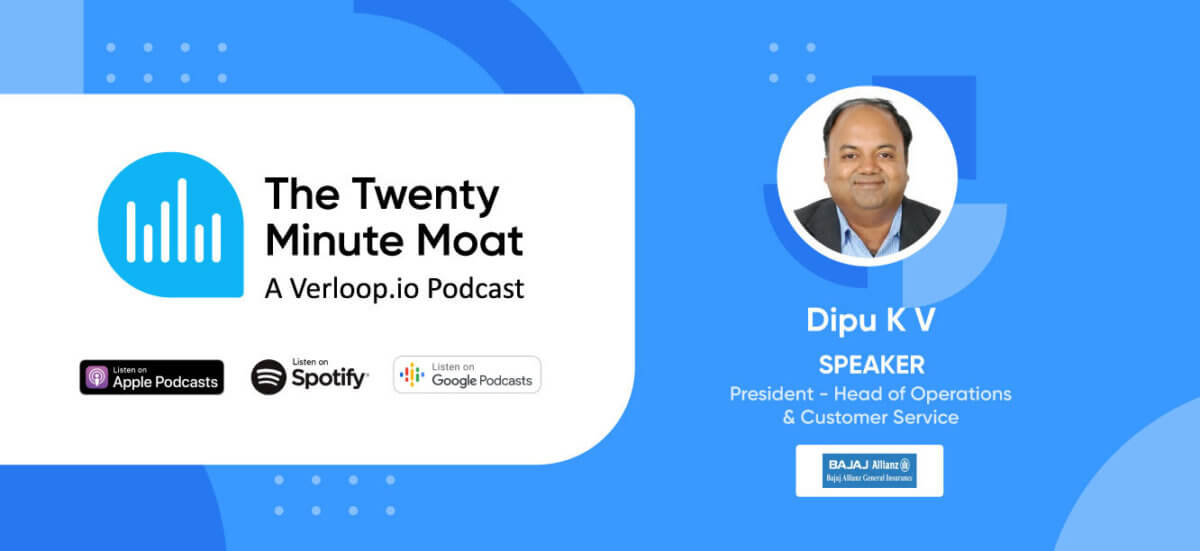Duration 14:00
Guest Speaker
Industry
E-commerce
Sumitra Patnaik is a Green Belt Six Sigma certified professional with over 15 years of experience in the industry and heads customer support for the classifieds business in OLX India. In her current role, she is responsible for driving consistency in customer support standards across various customer touch-points and balancing the customer support strategy with both operational delivery and process efficiency.
We cover:
- [2:40] What customer support looks like at OLX India
- [3:40] Impact of the Covid-19 pandemic
- [5:15] Is there a need to reimagine customer support
- [6:50] Automation and customer support
- [10:13] Customer support and building a sense of community
- [11:23] Best practices in customer support
- [13:52] How customer support will evolve in the coming years
Podcast Transcript
In this opportunities for customer support podcast, we have Sumitra Patnaik as our podcast guest and Siddharth Sharma as our podcast host.
[0:25] Siddharth Sharma
Today, I have a very special guest with me, Sumitra Patnaik, who is the head of customer support at OLX India. Sumitra is a Greenbelt Six Sigma certified professional, with over 15 years of experience in the industry. Currently heading customer support for the classified business in OLX India.
In her current role, she is responsible for driving consistency in customer support standards across various customer touch-points and balancing the customer support strategy with both operational delivery and process efficiency.
Sumitra, welcome to the show.
Sumitra Patnaik
Thanks Siddharth. It’s a pleasure being on your show.
Siddharth Sharma
Sumitra, why don’t you start off by introducing yourself and your role to our listeners?
Sumitra Patnaik
Yeah, sure.
I am a Greenbelt Six Sigma certified professional with over 15 years of experience and my experience has been varied, but yes, more focused towards… uh… customer relationship management and customer support.
And is a… why I am very passionate about… uh… you know, the… the role that I am in currently, where I head customer support for OLX India.
Uh, where I try and, you know, uh, have a consistency in terms of the standards and best practices for the team and where… where we truly come out as a customer-centric organisation.
[1:40] Siddharth Sharma
You have very rich experience and a very varied experience, right? And this is where I would like to pick on your experience and your thought processes. How do you feel the industry has evolved over the last few years and especially over the last year?
Sumitra Patnaik
So… I’d say, you know, COVID 19 has bought in a massive disruption, right, and has left a lasting mark on customers. So it was no different for us. And since, you know, the onset of the pandemic, I think the biggest shift has been in customers now wanting more of safe exchanges rather than fast exchanges.
In these rather unusual times, keeping a real-time check on the changing preferences and quickly innovating to redesign customer journeys will be key.
[2:40] Siddharth Sharma
Completely agree with you on there. I mean now, you know, let’s deep dive into customer support, right? Given that you’ve been in the customer support and, you know, managing the entire team at OLX, especially in the classified business, how is customer support seen?
Sumitra Patnaik
At OLX we love to unlock value for our customers and every single month we have over 320,000,000 people use our platforms to easy, safely and conveniently find what they’re looking for, so be it, you know, finding their perfect home or say, buy or sell a car, find a great job or sell things they don’t need, or even you know, strike a great deal on something that they would need. So, having said that, we are a truly customer centric company from defining those opportunities to designing our products and thereby solving these customer challenges that come on our way.
[3:40] Siddharth Sharma
You talked about customer challenges, right? And I’ll just pick you on this. What were the major customer challenges you faced in the past year and how much of an impact did the pandemic have on your industry and business?
Sumitra Patnaik
Here, I would like to, you know, replace the word challenges, because I saw these as opportunities, you know. And I believe that the pandemic did expose the industry to a plethora of opportunities to prepare for 2020 and beyond. And, no doubt, service teams were tested like never and forced to you know, adapt quickly to say the new and uncertain situations that came our away.
But as a business, the shift to remote work has not impacted… say, our productivity or operations as much because we were very quick to move to a work from home setup with the necessary tools and technology in place.
What I’d say came as a real channel… you know, a challenge for us was an increase in, say, case volumes for a couple of months which obviously had a cascading effect, you know, on some of the other key metrics for us which were very relevant and very important, like customer satisfaction scores and the abandoned rate going a little high with repeat callers calling us back to back and… operationally there was some fluctuation, but overall we saw this as an opportunity which helped us rectify a lot of things which we were not thinking in the normal times.
[5:15] Siddharth Sharma
You talked about, you know, how it… given the pandemic, how your team completely shifted and, you know, how, with the help of tools… do you feel there is a need to reimagine the way customer support has evolved over the years?
Was the pandemic a turning point that has forced organisations to innovate when it comes to engaging with customers?
Sumitra Patnaik talks about customer engagement strategies
So, customer support has definitely evolved over the years from, say having limited options to, you know, either have your queries resolved through, say, the telephony system or, say, you know, reach out to an email support desk, to today where we have multi-channel options available as per the customer’s preference and the urgency, of course.
And while I agree that the pandemic did catch us off guard and compelled us to rethink innovation while engaging with customers, but what I feel, in my mind, innovation comes only after one has identified the why and the need of it. Maintaining a strong customer experience during all times, according to me, is necessary, and it requires a lot of research and in-depth understanding of the changing patterns and the newer customer pain points that keep emerging.
So once you are alert on those and that understanding becomes very clear, then the planning for an imitation and innovation becomes a much easier process, which then translates into great customer engagement.
[6:50] Siddharth Sharma
Got it. And this is a question that I keep going back to a lot of leaders and ask them, right? Given that we have a technology and we’re using technology in and out, do you still get customers who still insist on interacting with customer agents? And in your opinion, what is the portion or the percentage of processes that are okay to be automated?
Sumitra Patnaik
So, what I believe Siddharth here is, customer service cannot be completely automated as you’ll always have some… a set of customers who prefer that human connect.
There are times also where… if you step into a customer’s shoes and… who are in a… you know, you’ll need some answers to your questions, Sometimes you’re comfortable speaking to somebody rather than going through chat bots or automated stuff, which probably doesn’t solve or give you that answer.
So we try and keep that in mind while we try to strike a fine balance between automation and how much we want to automate while keeping this human connect alive.
But having said that, with intelligent technologies deployed at the system level, we have automated significant parts of our processes.
Something which is very routine like say ticket categorizations or automating generic customer queries or sending out surveys or, you know, automating answer recommendations or solutions, these help in quicker resolutions, no doubt, so it… it really makes sense to do so.
And I, I think that it… it also gives the team more time to focus on the value-added and the relevant interactions with customers, which is more important and… and then it starts to impact our, you know, the key metrics like your customer satisfaction, which we..uh… we think is very important.
And of course, a first call resolution for us also is something that we really focus on so that customers don’t have to call us back.
[9:00] Siddharth Sharma
Alright. And while we’re talking about technology and we talked about, you know, automating a certain routine queries, how do you think chat bots and automation in general in the customer support industry will help us stay scalable?
Sumitra Patnaik
Personally, I think chat bots are great way to offer users real time and round the clock, you know, support to. At least the queries which are very generic in nature.
And which do not need human intervention. So customers expect a very speedy solution…uh… at times, right, where they will need that answer quickly for something which they don’t have to really go through your complex, you know IVR or they don’t have to wait for some time to connect with you and chat bots really give you that leverage and can… we can answer a lot of questions for you and no matter what time of the day it. So that’s the best bit of chat bots and they also help you level out the query volumes across channels and, you know, reduce the manpower costs and simplify tasks and, you know, remove the repetition from the workflows.
[10:13] Siddharth Sharma
Got it. Understood.
When we talk about the customer support, we typically talk about, you know, building us… like you know, building a community which propels your brand forward.
So in terms of that ,right, how is, uh, OLX right, is building a sense of community with its customers and your thoughts on how, you know, changes in the way customer interacts with the brand can be actually Very crucial.
Sumitra Patnaik
Well, our organization does invest in reputable projects and, you know, that enable local communities to transition to a lower carbon economy. And on your second point of how, you know, I think the changes… in the way customer’s interact helps the brand, I think it’s… it’s really, you know, it is very important and keeping a close watch on the way, you know, the changes in ways customers interact were useful.
Why I say so? Because it helps the brand sense the… you know, the need for any kind of a change in terms of they redesigning a journey or a particular process, or even modifying existing touch points from time to time. It really helps to keep a tab.
[11:23] Siddharth Sharma
And this is something which I had been, you know, meaning to ask you since I started the podcast with you and I stared the discussion. What do you think are the best practices when it comes to providing customers with delightful experience?
And I’m going to break this question into two parts. Your thoughts on what used to work and what works today.
Sumitra Patnaik talks about the strategies for delightful customer support experience
Sure, so I’ll… I’ll answer… I’ll try and answer this one, you know, in the most appropriate way while sharing my personal thoughts here.
So creating a delightful support experience… I think is a continuous journey. It is a continuous process of improvisation and is evolving as we speak. So to say, you know you can…seldom follow a rule book of best practices because a best practice here, you know, practice yesterday may not be the best practice today. So, like I said, it is continuously evolving, you know, and the experience cannot be measured with… with a particular metric.
It’s about an experience that we’re talking of. It is about the customers emotions in this journey with the brand. So I think it is more than just one interaction or a few interactions. It is a whole gamut of other sub-experiences that determines this overall experience, which is the final outcome. So even, you know… you know, things like how easy is it to reach the customer care number, or how… how quickly do you get a response to your query, or you know, do you have to navigate through complex voice systems to, you know, finally talk to an agent.
Or the… is the chat bot even effective enough to answer what you’re looking at. And lastly, the… you know the effective issue resolution which has in depth understanding of the problem and which gives you the… you know with… where they give you the accurate solutions for your problem so that you don’t have to run pillar to post to kind of solve for it. So, these are experiences in a whole… you know, you know if I look at it from that point of view and just one experience, so or just one…
If we fix one thing, it cannot determine how good your customer experience has been. It… it is like a process which you have to maintain.
[13:52] Siddharth Sharma
Got it.
And this is something for all our listeners out there. Because, you know, you’ve seen the transition of the industry completely. How do you think customer support will evolve in the next two years?
Sumitra Patnaik
Well, I think that technology plays an important role here. and, when I look at customer support in the next two years, I think technology brings in that much needed flavor to customer support with a whole lot of excitement.
And newer and easier ways to connect with your customers. So, be it, you know, sharing transactional information or education on… education through… through videos or real time messaging, chat bots, AI or even intuitive self service.
You know, all of these have the potential to make the big impact in the day-to-day workings of customer success practitioners.
[14:46] Siddharth Sharma
Got it. And again, your thoughts on how the tech should evolve in the customer support space?
Sumitra Patnaik
Tech is already evolving and I think… like I said, I think I only answered this question where I said tech is the much-needed flavour that customer support has been waiting for and it goes without saying that product interventions and technology changes are what is making customer support… you know, relevant in these times and tech no doubt will play an important role.
Siddharth Sharma
Thank you so much for being on this show with us, Sumitra. I, you know, I couldn’t stop asking questions, but yeah, I mean that is the point where you need to stop it.
Thank you so much and thank you so much for sharing your thoughts. Have enjoyed every bit of it.
Sumitra Patnaik
Thanks, Siddharth. I did have a wonderful time speaking to you.



